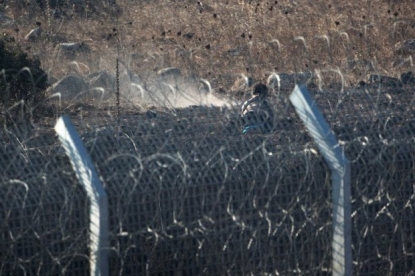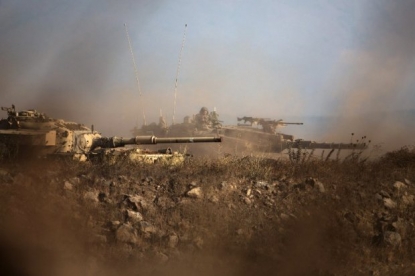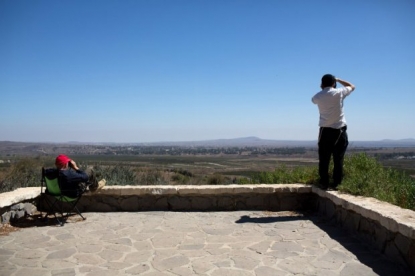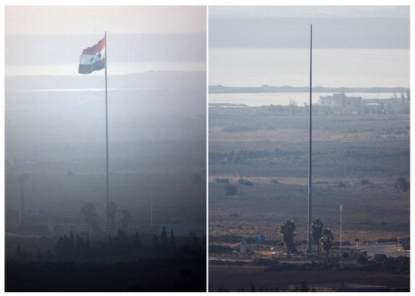War as spectator sport in the Golan Heights
MOUNT BENTAL, Golan Heights - September 16, 2014 - It is before dawn on the Golan Heights and a squad of Syrian government troops are engaged in fierce combat with rebels of the Al-Qaeda linked Al-Nusra Front.
The clashes are taking place just metres from the barbed wire fence that separates the Syrian side of the strategic plateau from the Israeli-held sector.
I am watching from an abandoned Israeli army bunker, around 100 metres from the demarcation line. This is war, taking place right before my eyes, and yet it could almost be another world. I am not a target, and none of the fighters cares remotely what is happening on the Israeli side.
I have the strangest sense of being in a movie theatre.
 A syrian rebel opens fire towards Syrian government forces near the Quneitra border crossing, on the Syrian side of the Golan, on September 1, 2014 (AFP Photo / Menahem Kahana)
A syrian rebel opens fire towards Syrian government forces near the Quneitra border crossing, on the Syrian side of the Golan, on September 1, 2014 (AFP Photo / Menahem Kahana)My colleague and I arrived at 6 am, after travelling down a dirt road. Luckily for us, on that day the Israeli army had not blocked access to the zone.
The Golan landscape is cloaked in a thick dawn fog. When it lifts about two hours later, I can clearly see the Syrian side through my 500 mm camera lens.
Suddenly comes the clatter of automatic gunfire and mortar, and I spot the Syrian army commando, hidden behind a crumbling stone wall around 400 metres from where I stand.
Then, to my right, I see the rebels. Both sides are lying in ambush about 100 metres apart. The Syrian soldiers start creeping towards the rebel positions, and lobbing grenades at them.
 An Israeli soldier sits in his Merkava tank on alert position on the Israeli-annexed Golan Heights near the Quneitra crossing with Syria, on September 1, 2014 (AFP Photo / Menahem Kahana)
An Israeli soldier sits in his Merkava tank on alert position on the Israeli-annexed Golan Heights near the Quneitra crossing with Syria, on September 1, 2014 (AFP Photo / Menahem Kahana)The Al-Nusra rebels fire back and a group of snipers split off to attempt a flanking manoeuvre, before taking up positions right up against the barbed wire, between the Syrian troops and my spot.
The gunfight scales up in intensity, with three mortar shells landing by mistake on Israeli-controlled territory -- prompting the army tanks stationed on my side of the border to rumble into a warning manoeuvre.
Things are getting too dangerous to stay out in the open, so we take shelter inside the empty bunker. We stay there for about 20 minutes, until things start quietening down a little and we leave.
 In a picture taken from the Israeli-annexed Golan Heights, smoke billows from the Syrian village of Quneitra following an explosion during fighting on August 31, 2014 (AFP / Menahem Kahana)
In a picture taken from the Israeli-annexed Golan Heights, smoke billows from the Syrian village of Quneitra following an explosion during fighting on August 31, 2014 (AFP / Menahem Kahana)Higher up on the Israeli-held Golan plateau, we pass a scenic overlook where clusters of people have gathered to watch the fighting inside Syria, just a kilometre away.
They can't see the actual fighters, as I could from my spot beside the border. But they can clearly see bombing, explosions and smoke, and the rebel flag hoisted in place of the Syrian one at the Quneitra border post…
Some make it a family outing. Others bring folding chairs and sit there for an hour or so with their binoculars. Most live here in the Golan, but there are tourists, too, fitting a slice of real-life civil war in between sightseeing trips to the many historical sites linked to the 1973 Yom Kippur war.
Right now is a beautiful time of year in the Golan Heights, a season sweet with the grape and apple harvests. What a strange contrast between this bucolic atmosphere, and the raging combat inside Syria.
 Israeli civilians stand near Mount Bental, in the Israeli-annexed Golan Heights, as they watch through binoculars the fighting between Syrian government troops and Islamist rebel fighters on September 2, 2014 (AFP Photo / Menahem Kahana)
Israeli civilians stand near Mount Bental, in the Israeli-annexed Golan Heights, as they watch through binoculars the fighting between Syrian government troops and Islamist rebel fighters on September 2, 2014 (AFP Photo / Menahem Kahana)Israeli forces allow people to walk up close to the demarcation line, so as not to drive tourists away. But this is not without danger. Not long ago some mortar shells fired from Syria landed in a kibbutz just behind the overlook where tourists gather for a view into Syria.
Probably an accident: neither the Syrian army nor the rebels seem to be deliberately targeting the Jewish state.
Israel, which is technically at war with Syria, seized 1,200 square kilometres (460 square miles) of the Golan Heights during the 1967 Six-Day War and later annexed it in a move never recognised by the international community.
Since the Syrian conflict erupted in 2011, the plateau has been tense, with a growing number of rockets and mortar rounds hitting the Israeli side, mostly stray, prompting occasional armed responses.
 A Syrian flag near the Quneitra border crossing was removed by rebel fighters on September 1, 2014 (AFP / Menahem Kahana)
A Syrian flag near the Quneitra border crossing was removed by rebel fighters on September 1, 2014 (AFP / Menahem Kahana)The Israeli army has a stronghold on the Golan Heights, allowing it to dominate the surrounding region. Whenever fighting threatens to spill over its border, Israel's tanks send a few warning shots towards the Syrian side.
These photos of war-spectators remind me of a series I took in July, during the war in Gaza, on a hilltop in Sderot where Israelis from towns and villages near the border gathered to watch the bombing of the Palestinian enclave.
But in reality the two situations are quite different: on the one hand, a conflict to which Israel is not party, on the other a war between the Jewish state and Hamas.
In the Golan, the viewpoints where people come to watch the fighting are never targeted. In Sderot, though, Hamas regularly aimed rockets at the hilltop from which people watched the fighting. The spectators there were not tourists but locals, used to the cycle of Hamas rockets and Israeli counter-fire.
Sderot is a village where nothing much happens. Both in times of war and peace, the locals have little to do other than clamber up a hill and look towards Gaza...
 Israeli residents, mostly from the southern Israeli city of Sderot, stand on a hill overlooking the Gaza Strip, on July 12, 2014, to watch the fighting between the Israeli army and Palestinian militants (AFP / Menahem Kahana)
Israeli residents, mostly from the southern Israeli city of Sderot, stand on a hill overlooking the Gaza Strip, on July 12, 2014, to watch the fighting between the Israeli army and Palestinian militants (AFP / Menahem Kahana)Menahem Kahana is an AFP photographer based in Jerusalem.


